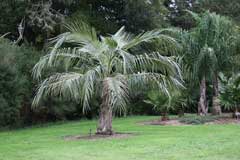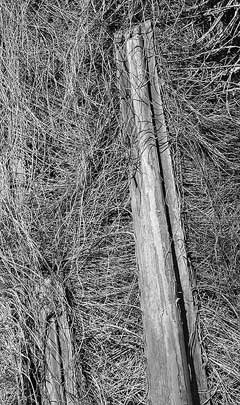 |
|
http://commons.wikimedia.org/wiki/User:Kahuroa |
 |
| http://www.flickr.com/people/64476710@N00 |
Translate this page:
Summary
Physical Characteristics

 Parajubaea cocoides is an evergreen Tree growing to 15 m (49ft 3in) at a medium rate.
Parajubaea cocoides is an evergreen Tree growing to 15 m (49ft 3in) at a medium rate.
It is frost tender. It is in leaf all year. The species is monoecious (individual flowers are either male or female, but both sexes can be found on the same plant).
Suitable for: light (sandy), medium (loamy) and heavy (clay) soils. Suitable pH: mildly acid, neutral and basic (mildly alkaline) soils. It can grow in semi-shade (light woodland) or no shade. It prefers moist soil.
UK Hardiness Map
US Hardiness Map
Synonyms
Plant Habitats
Woodland Garden Secondary; Sunny Edge; South Wall. By. West Wall. By.
Edible Uses
Edible Parts: Oil Seed
Edible Uses: Oil
Seed - raw or cooked[196]. A sweet taste, it is a very popular food with children[196]. The seed is about 2cm long[200]. An edible oil is obtained from the seed[196].
References More on Edible Uses
Medicinal Uses
Plants For A Future can not take any responsibility for any adverse effects from the use of plants. Always seek advice from a professional before using a plant medicinally.
None known
References More on Medicinal Uses
The Bookshop: Edible Plant Books
Our Latest books on Perennial Plants For Food Forests and Permaculture Gardens in paperback or digital formats.

Edible Tropical Plants
Food Forest Plants for Hotter Conditions: 250+ Plants For Tropical Food Forests & Permaculture Gardens.
More

Edible Temperate Plants
Plants for Your Food Forest: 500 Plants for Temperate Food Forests & Permaculture Gardens.
More

More Books
PFAF have eight books available in paperback and digital formats. Browse the shop for more information.
Shop Now
Other Uses
References More on Other Uses
Cultivation details
Management: Standard Regional Crop Staple Crop: Oil Staple Crop: Sugar
Requires a sunny sheltered position in a well-drained soil but with plenty of water in the growing season[196]. Plants probably require a cool summer and quickly lose vigour in areas where night temperatures do not fall below 13°c[196]. Plants experience sub-zero temperatures in their native range and it should therefore be possible to grow them in warm temperate zones that only experience occasional light frosts[200]. They will possibly succeed in the milder areas of Cornwall[231]. This species has a deep penetrating root systems and generally establishes best when planted out at a young stage. It is not suitable for container cultivation[231]. Older plants are substantially more cold tolerant than juvenile plants[231], so if the plants can be protected from frosts in their earlier years it might be possible to grow them in areas at the limit of their cold tolerance. Plants are relatively fast-growing for a palm and can produce fruit in 4 years from seed[196]. Trees are deep rooted[196].
Carbon Farming
-
Management: Standard
Plants grow to their standard height. Harvest fruit, seeds, or other products. Non-Destructive management systems.
-
Regional Crop
These crops have been domesticated and cultivated regionally but have not been adopted elsewhere and are typically not traded globally, Examples in this broad category include perennial cottons and many nuts and staple fruits.
-
Staple Crop: Oil
(0-15 percent protein, 16+ percent oil). Some of these are consumed whole while others are exclusively pressed for oil. Annuals include canola, poppyseed, maize, cottonseed, sunflower, peanut. Perennials include high-oil fruits, seeds, and nuts, such as olive, coconut, avocado, oil palm, shea, pecan, and macadamia. Some perennial oil crops are consumed whole as fruits and nuts, while others are exclusively pressed for oil (and some are used fresh and for oil).
-
Staple Crop: Sugar
Perennial sugar crops include sugarcane and compare favorably to annuals.
References Carbon Farming Information and Carbon Sequestration Information
Temperature Converter
Type a value in the Celsius field to convert the value to Fahrenheit:
Fahrenheit:
The PFAF Bookshop
Plants For A Future have a number of books available in paperback and digital form. Book titles include Edible Plants, Edible Perennials, Edible Trees,Edible Shrubs, Woodland Gardening, and Temperate Food Forest Plants. Our new book is Food Forest Plants For Hotter Conditions (Tropical and Sub-Tropical).
Shop Now
Plant Propagation
Seed - sow in a warm greenhouse as soon as it is ripe. It usually germinates freely. Stored seed is more difficult to germinate, it should be pre-soaked for 24 hours in warm water before sowing in a warm greenhouse. When they are large enough to handle, prick the seedlings out into individual pots and grow them on in the greenhouse for at least their first two winters. Plant them out into their permanent positions in late spring or early summer, after the last expected frosts. Give them some protection from the cold for their first few winters outdoors.
Other Names
If available other names are mentioned here
Native Range
SOUTHERN AMERICA: Ecuador
Weed Potential
Right plant wrong place. We are currently updating this section.
Please note that a plant may be invasive in one area but may not in your area so it's worth checking.
Conservation Status
IUCN Red List of Threatened Plants Status :

Growth: S = slow M = medium F = fast. Soil: L = light (sandy) M = medium H = heavy (clay). pH: A = acid N = neutral B = basic (alkaline). Shade: F = full shade S = semi-shade N = no shade. Moisture: D = dry M = Moist We = wet Wa = water.
Now available:
Food Forest Plants for Mediterranean Conditions
350+ Perennial Plants For Mediterranean and Drier Food Forests and Permaculture Gardens.
[Paperback and eBook]
This is the third in Plants For A Future's series of plant guides for food forests tailored to
specific climate zones. Following volumes on temperate and tropical ecosystems, this book focuses
on species suited to Mediterranean conditions—regions with hot, dry summers and cool, wet winters,
often facing the added challenge of climate change.
Read More
Expert comment
Author
Burret.
Botanical References
200
Links / References
For a list of references used on this page please go here
Readers comment
| Add a comment |
|
If you have important information about this plant that may help other users please add a comment or link below. Only comments or links that are felt to be directly relevant to a plant will be included. If you think a comment/link or information contained on this page is inaccurate or misleading we would welcome your feedback at [email protected]. If you have questions about a plant please use the Forum on this website as we do not have the resources to answer questions ourselves.
* Please note: the comments by website users are not necessarily those held by PFAF and may give misleading or inaccurate information.
To leave a comment please Register or login here All comments need to be approved so will not appear immediately.
|
Subject : Parajubaea cocoides
|
|
|
|